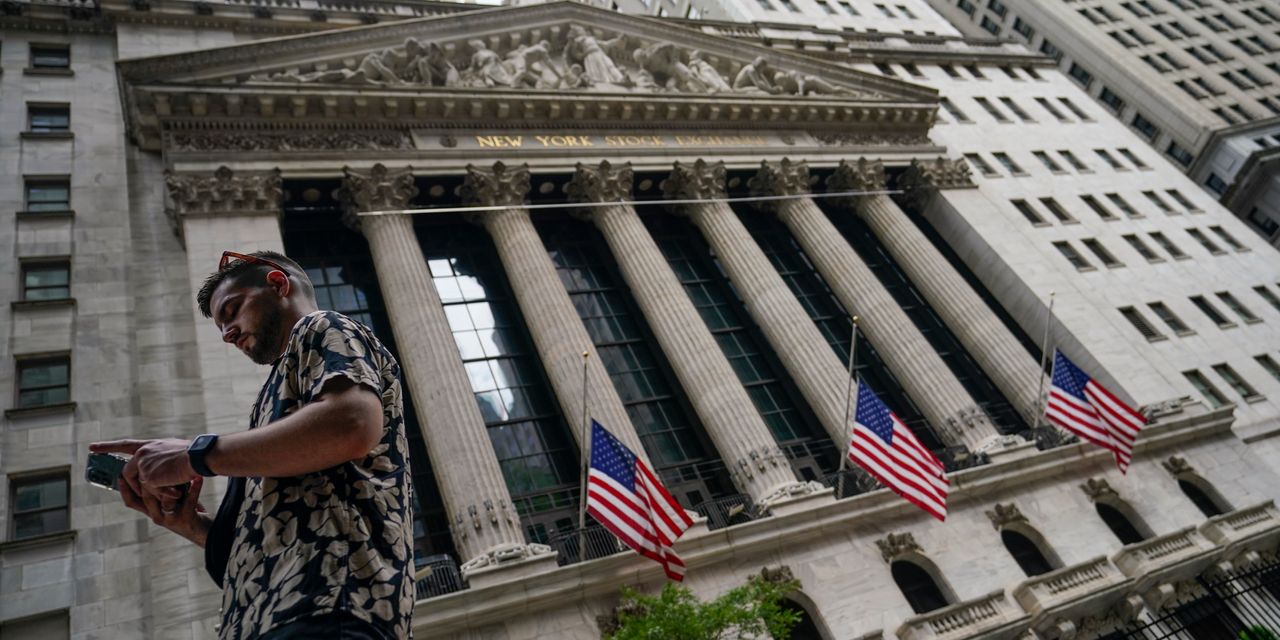U.S. stocks struggled for direction on Tuesday after the three major indexes posted their worst daily drop in two months on Monday, leaving Wall Street in danger of a third consecutive day of losses, as higher bond yields and a rampant dollar reflected resurgent fears of Federal Reserve interest rate hikes.
How are stock-index futures trading?
-
The S&P 500
SPX
gained 6 points, or 0.2%, to 4,144 -
The Dow Jones Industrial Average
DJIA
was down 58 points, or 0.2%, to 33,004 -
The Nasdaq Composite
COMP
rose 43 points, or 0.4%, to 12,424
On Monday, the Dow Jones Industrial Average fell 643 points, or 1.91%, to 33064, the S&P 500 declined 90 points, or 2.14%, to 4138, and the Nasdaq Composite dropped 324 points, or 2.55%, to 12382.
What’s driving markets?
The recent summer surge in U.S. stocks was still looking fragile on Tuesday. After rallying more than 17% from its mid-June low on hopes the Fed may slow its monetary policy tightening cycle, the S&P 500 index has struggled to maintain its advance over the past several sessions.
The S&P 500 closed at a three-month high on Aug. 16 but has lost 3.9% since then “amid a toxic cocktail of fears around inflation, possible recession and further shortages of energy supplies,” said Richard Hunter, head of markets at Interactive Investors.
“There is perhaps a growing realization that the Federal Reserve will remain unmoved by recent data which suggested that inflation could be peaking and maintain its aggressive policy,” Hunter added.
Ipek Ozkardeskaya, senior analyst at Swissquote Bank, noted that ahead of the Fed’s Jackson Hole symposium starting on Thursday, investors had become more wary that Chairman Jay Powell will seek to cement his hawkish stance.
“Now that the Jackson Hole meeting approaches, those [bullish stock market] bets are vanishing, as there is no way the Fed will soften its tone while inflation still hangs around the 8.5% level,” Ozkardeskaya said in a morning note.
U.S. stocks suffered their worst daily drop in two months Monday as investors braced for hawkish messages from the Federal Reserve officials, while looking to this week’s Jackson Hole Economic Symposium for more clarity on interest rates. Chair Powell is expected to deliver a speech on the economic outlook on Friday at 10 am ET.
“Powell will be relatively hawkish on Friday. I think the market is anticipating that, and that’s why the selloff,” Chris Grisanti, chief equity strategist at MAI Capital Management in New York, told MarketWatch via phone. “I would say that in September, they’ll probably do 50 basis points, but I don’t think there’s any reason to cheer. I think they’re going to start to tone down the massive moves and just have a continuing series of 50 or 25 basis point moves going forward.”
Much of the equity market’s recent rally has been predicated on lower long-term borrowing costs, but benchmark 10-year Treasury yields
BX:TMUBMUSD10Y,
which nearly fell below 2.5% two months ago, were back above 3% as the market adjusts its Fed narrative.
Such moves, alongside rises in overnight and short-duration U.S. bond yields are also boosting the dollar index
DXY,
which is again flirting with 20-year highs. This was putting further pressure on stocks because it makes U.S. goods and services less competitive abroad and diminishes companies’ repatriated earnings.
Another factor causing angst among investors of late is the Russia-induced sharp rise in natural gas prices across Europe that have raised concerns the continent will fall into a steep recession this winter.
See: U.S. economy slows again, S&P finds, due to high inflation and rising interest rates
In U.S. economic data, the S&P Global U.S. flash manufacturing purchasing managers index (PMI) fell to 51.3 in August from 52.2 in July, a 25 month low, while the services sector PMI fell to 44.1 in August from 47.3 in July, a 27-month low.
Meanwhile, U.S. new home sales plunged 12.6% to a seasonally-adjusted rate of 511,000 in July, from a revised 585,000 in the prior month, the Commerce Department reported Tuesday. Analysts polled by the Wall Street Journal had forecast new home sales to come in at 574,000 in July.
Which companies were in focus?
-
Shares of Zoom Video Communications Inc.
ZM
slumped 12.1% after the company indicated challenges in its core business, which are related to the strong U.S. dollar and subscription growth in Zoom’s online channel, which is made up of customers who don’t engage with Zoom’s direct sales team or sales partners. -
Palo Alto Networks Inc.
PANW
shares surged 11.2% after the cybersecurity company said its forecast topped Wall Street estimates. -
Macy’s Inc.
M
shares jumped 8.4% after the department store chain posted better-than-expected earnings for the second quarter, although it lowered its full-year guidance to reflect a difficult spending environment and high levels of inventory. Macy’s reported adjusted earnings of $1 on revenue of $5.6 billion.
How are other assets faring?
-
Oil futures were higher with West Texas Intermediate crude for October delivery
CLV22
advancing 3.7% to $93.74 per barrel on the New York Mercantile Exchange. U.S. natural-gas prices traded at a 14-year high as Europe’s looming energy crisis fuels fears of a total shutdown. -
The yield on the 10-year Treasury
BX:TMUBMUSD10Y
was 3.012% compared with 3.035% on Monday afternoon. The yield on the 2-year Treasury
BX:TMUBMUSD02Y
was 3.255% versus Monday’s level of 3.335%. -
Gold priced
GC00
climbed with gold futures for December delivery
GCZ22
rising 0.8% to $1,762.70 an ounce. -
Bitcoin
BTCUSD
advanced 0.6% to $21,519. -
Asia markets fell back in tandem with Wall Street’s overnight decline. Japan’s Nikkei 225
JP:NIK
finished 1.2% lower and Hong Kong’s Hang Seng
HK:HSI
shed 0.8%. In Europe, the Stoxx 600
XX:SXXP
recovered much of its early losses to trade down 0.1%.
